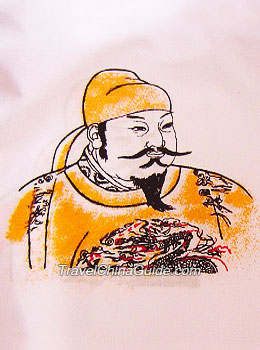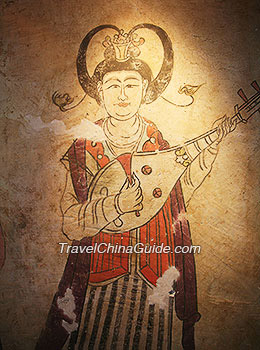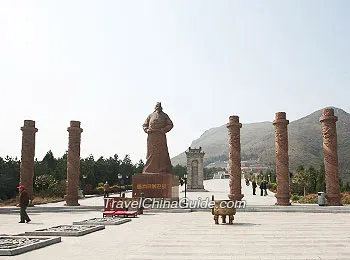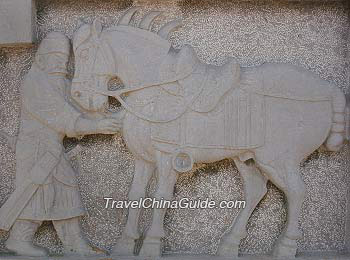Li Shimin - Emperor Taizong of Tang
 |
| Emperor Taizong of Tang Dynasty |
As Qin Yang, he launched many military expeditions against his rivals. He eradicated the tensions in the northwest part of Tang by defeating the local military force in Gansu; his army crushed Song Jingang's troops and recovered Bingzhou and Fenzhou cities; he also annihilated the military forces of Wang Shichong and Dou Jiande and conquered the central plains. These successes allowed broad expansion of Tang territory. However, as his military power grew stronger and stronger, Li's two brothers grew envious and concerned. Prince Li Jiancheng specifically feared that Li Shimin would replace him. The fear drove him to fashion a plot to eliminate Li and grasp his military power. Hearing of the plot, Li Shimin informed against his two brothers to his father. Meanwhile he deployed his soldiers inside the Xuanwu Gate through which his two brothers would go to meet Li Yuan the next day. On July 2nd, 626 the brothers attempted a coup. Eventually it failed and Li Shimin and his forces killed the two brothers. Chinese history refers to this as the Xuanwu Gate Incident. Three days later, he became Prince. Two months later, Li Yuan abdicated in favor of Li, the latter becoming Emperor Taizong. This marked the start of the Zhenguan Reign considered one of the golden ages of Chinese history.
|
|
As Emperor Taizong, Li Shimin's military talents were brought to fruition. Successively, he defeated the Tujue in the north and captured Tuguhun and Gaochangguo in the west. This made Tang the dominant power in eastern Asia and Emperor Taizong subsequently took the title of ‘Heavenly Khan'. In 638, he defeated Tufan leader Sontzen Gampo's army, but later allowed Princess Wencheng to marry Gampo. In dealing with state affairs however, Li Shimin learned hard lessons about the reasons of the Sui's downfall. One example was the war he launched against Gaoli in his later years that proved to be a waste of money and manpower. But Li was also smart and modest enough to invite criticism from his advisers. A loyal chancellor named Wei Zheng actually pointed our more than 200 mistakes made over time by the emperor who ultimately corrected all of them. The emperor proved to be eventually thrifty and cared a great deal about his people. Additonally, he gave equal treatment to ethnic minorities. He appointed many of them as high officials in his court. As a politician, he enhanced the former political systems, cuach and Jun Tian System (Land Equalization System); Keju Educational System and the Three Departments and Six Ministries System. Trying to rule the country by law, he also promulgated Da Tang Lv (state law of Tang) which had a profound influence in Chinese history.
 |
| Colorful Mural of Tang Dynasty, Zhaoling Mausoleum |
Li Shimin also had highly developed literary taste. He composed many poems and was an accomplished calligrapher. In order to teach his offspring and memorialize his imperial experience, he wrote a book called Di Fan (model of an emperor). Another important book called Zhen Guan Zheng Yao catalogued all of his administrative experience and became a reference book for monarchs and leaders in many other countries. During Emperor Taizong's twenty years' reign, the national economy became prosperous, society was reasonably stable and people lived in peaceful harmony. This is why his reign is remembered as Zhen Guan and as the foundation for the later glorious period of the Tang Dynasty.
As he grew older, Li Shimin has difficulty selecting his successor. At first he chose his eldest son Li Chengqian as Prince. Later, he put his fourth son Li Tai into an important position which made Li Chengqian suspicious. The latter launched a coup and attempted to kill Li Tai. The plot failed and Li Chengqian was demoted to plebeian status. For fear that the tragedy of Xuanwu Gate might be replayed, Li Shimin then demoted Li Tai and chose his ninth son Li Zhi as Prince. He later would become Emperor Gaozong.
In 649, Emperor Taizong contracted dysentery and soon after died at Hanfeng Palace in Chang'an. Later he was buried in northeast Liquan County in Shaanxi Province. His tomb is called Zhao Ling (Zhao Mausoleum).

